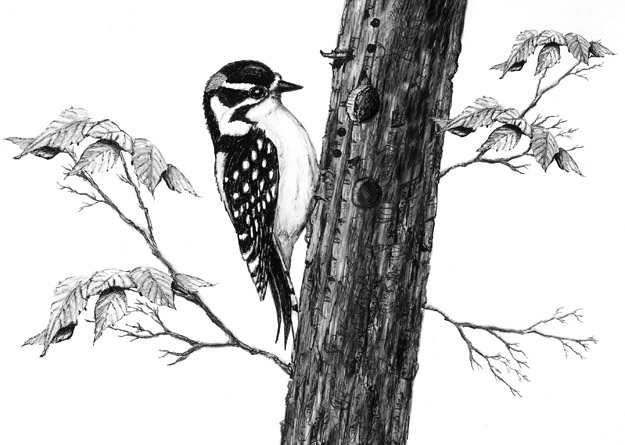
Dear Bird Folks,
While I was walking down a dirt road I noticed two woodpeckers pounding away on the nearby trees. As I watched them I began to wonder how they find their food. I mean, how do they know where to peck? Unless they have a good system they could peck until their brains are addled and still starve. Can you solve this mystery for me?
– Ranganath, Belmont, MA
Good for you, Ranganath,
It’s nice to hear from someone who is actually concerned about the wellbeing of our woodpeckers. This time of year most of the woodpecker questions I receive are filled with hatred and curse words. Spring is when woodpeckers like to announce their territories. They do that by drumming as loudly as they can on everything from tree trunks, to chimney caps, to aluminum gutters and on the sides of our homes. For some reason, people don’t like having extra holes drilled into their houses. (Like a little fresh air is going to kill them.) With that in mind, and before I answer your question, Ran (Is it okay if I call you “Ran”? Your full name is causing my spellchecker to overheat.), I think I’d better talk about the holes in the houses first. That will save me from writing about this same topic next week.
Unlike woodchucks, which rarely do any actual chucking of wood, woodpeckers are all about pecking on wood, and sometimes on things that aren’t wood. They peck while hunting for food, to dig out their homes and to announce their territories. During the mating season woodpeckers put their drumming skills into overdrive. Tree trucks are good for drumming, but trim boards on houses are better and metal chimney caps are better still. The birds want to make as much noise as they can. Drumming on a chimney cap is annoying, but hammering on a house sometimes causes damage and needs to be addressed. We find that hanging strips of shiny Mylar tape works best to keep them away from a particular spot. There, that’s all I’m going to say on this drumming topic. I have to get back to Ran’s question, and his addled, starving woodpeckers.
At last count, there are over 200 different species of woodpeckers in the world. It’s hard to nail down the exact number because at least ones species, the Ivory-billed, can’t seem to decide if it wants to be extinct or not. As you might expect in a family with so many members, there is an assortment of feeding methods, each designed to exploit available food. Some birds may search for food visually, others may dig for their food, while others may skip all of the work and just order takeout.
When foraging, many woodpeckers fly down to the base of a tree and slowly work their way up. As they move up the tree, their keen eyes constantly look into every nook and crevasse for any hiding insects or hidden insect eggs. If the tree bark is particularly shaggy, like on Cape Cod’s ubiquitous pitch pines, the birds may utilize another hunting method. Using their strong bills as spatulas, they’ll flip over hunks of bark to reveal any concealed bugs. These foraging habits may yield results, but sometimes the prey is not under the bark and is instead deep inside the tree. No problem. Woodpeckers are well equipped to access insects no matter where they are hiding. In such cases, the woodpeckers do what they do best: they start smashing their way into the core of the tree. This is a good time to stay out of their way.
Trees, both living and dead, play host to a large assortment of wood boring insects. Woodpeckers seek out the larvae of these insects, which often look like white chubby worms. By locating the worms’ entrance holes, woodpeckers know where to begin searching for these prized juicy critters. In addition, it is said that woodpeckers can find the exact location of the larvae by hearing them as they move about inside the tree. (You know they have good ears if they can hear a worm crawl.) Another way woodpeckers find the larvae is by tapping on the tree. Much like a carpenter taps on a plaster wall in search of a stud, a woodpecker taps on a tree and listens. If the tree sounds solid, it moves on. But if the tree sounds hollow, the bird knows that bugs are hollowing it out and quickly gets down to business. Using its strong tail as a brace, the bird leans back and starts hacking away. Once discovered, it’s only a matter of time before the insect larvae are no longer deep inside the tree, but instead, are deep inside a woodpecker.
Keep in mind that most woodpeckers are omnivores. If the bug hunting isn’t very good, they’ll happily make a meal out of seeds, nuts or acorns. They will also chow down fruit when they need to meet their daily requirement of Vitamin C. And don’t forget that woodpeckers also have a sweet tooth. Sapsuckers (which are woodpeckers) make tiny holes in tree bark. They then lap up the sweet sap as it oozes out and will quickly snag any insects that may also be attracted to the sap.
Like most birds, Ran, woodpeckers use an assortment of methods to locate food. While many of these hunting skills are innate, the birds undoubtedly get better at foraging as they get older. They learn which trees offer the best chances of finding food through experience, from watching other woodpeckers and by reading the ever popular Zagat guide to tree trunks.